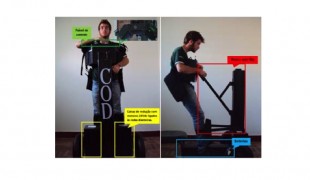- 10048
- 623
- 13
- 8
- 0
- Help Ukraine
About the solution
Due to her condition, Roberta cannot walk, and has difficulty swallowing and controlling the movements of her head and neck, so she has to wear a brace. Fabio developed the device because Roberta was always crying while using the conventional support, provided by the insurance, which was hurting her.
After two years, the father, who works in a high tech company, came up with a prototype, created at home, by himself.
"I've made one all alone in machined aluminum alloy. I had an ambitious goal: to create a more modular brace to the body of my child, something that in time could change and could be adjusted. Will power is my motto. And for Roberta I would have done everything”, the innovator explained.
This new device is better for the users because is about 40-45% lighter than the standard one, and is also more flexible.
"With this brace everything changes: the embrace becomes even stronger, because the structure is flexible. And today the peculiar thing is that other families have turned to me”, Fabio said.
The inventor has already new ideas: He his thinking about improving is daughter’s wheelchair, and about building a thermal pool.
Fabio presented his innovation Maker Faire Rome: The European Edition, in 2015.
Adapted from: http://bit.ly/2bQHQO9
What about you, do you have any solutions? Please share them with the Patient Innovation community!
This solution shall not include mention to the use of drugs, chemicals or biologicals (including food); invasive devices; offensive, commercial or inherently dangerous content. This solution was not medically validated. Proceed with caution! If you have any doubts, please consult with a health professional.
DISCLAIMER: This story was written by someone who is not the author of the solution, therefore please be advised that, although it was written with the utmost respect for the innovation and the innovator, there can be some incorrect statements. If you find any errors please contact the patient Innovation team via info@patient-innovation.com
-
-
357
-
0
-
3836

Hip & co- a mum's invention for hip dysplasia
CAREGIVING
BODY BALANCE: Maintaining body balance
STANDING UP: Standing up from a seated position
WALKING WITH A WALKING AID: Walking with a walking aid
WALKING: Walking
Hip Dysplasia
Assistive Daily Life Device (to help ADL)
Walking Aid (wheelchair/walker/crutches)
Difficulty walking or moving
Muscle weakness
Limited range of motion
Muscle pain or stiffness
Loss of muscle coordination
Muscle cramps or spasms
Joint deformity
Joint redness or warmth
Swelling or inflammation
Difficulty bearing weight
Numbness or tingling in the extremities
Frequent falls
Joint pain or swelling
Restoring mobility
Managing pain
Promoting self-management
Preserving Organ Function
Recovering from Traumatic Injuries
Maintaining Balance and Mobility
Raise awareness
Caregiving Support
General and Family Medicine
Orthopedics
Pediatrics
Australia
-
-
-
1013
-
9
-
27785

Mother creates device to help his son to walk again
WALKING: Walking
WALKING WITH A WALKING AID: Walking with a walking aid
Cerebral Palsy
Assistive Daily Life Device (to help ADL)
Body-Worn solutions (Clothing, accessories, shoes, sensors...)
Walking Aid (wheelchair/walker/crutches)
Impaired movement
Restoring mobility
Managing Neurological Disorders
Maintaining Balance and Mobility
Caregiving Support
Neurology
Pediatrics
Physical Medicine and Rehabilitation
Israel
-
-
-
547
-
0
-
7649

Dynamic Orthostatic Chair – A new locomotion method for disabled
WALKING WITH A WALKING AID: Walking with a walking aid
STANDING UP: Standing up from a seated position
WALKING: Walking
Cervical spinal cord injury/Tetraplegia
Walking Aid (wheelchair/walker/crutches)
Restoring mobility
Promoting self-management
To implement a diagnostic tool
Maintaining Balance and Mobility
General and Family Medicine
Neurology
Orthopedics
Pediatrics
Physical Medicine and Rehabilitation
Brazil
-
 en
en